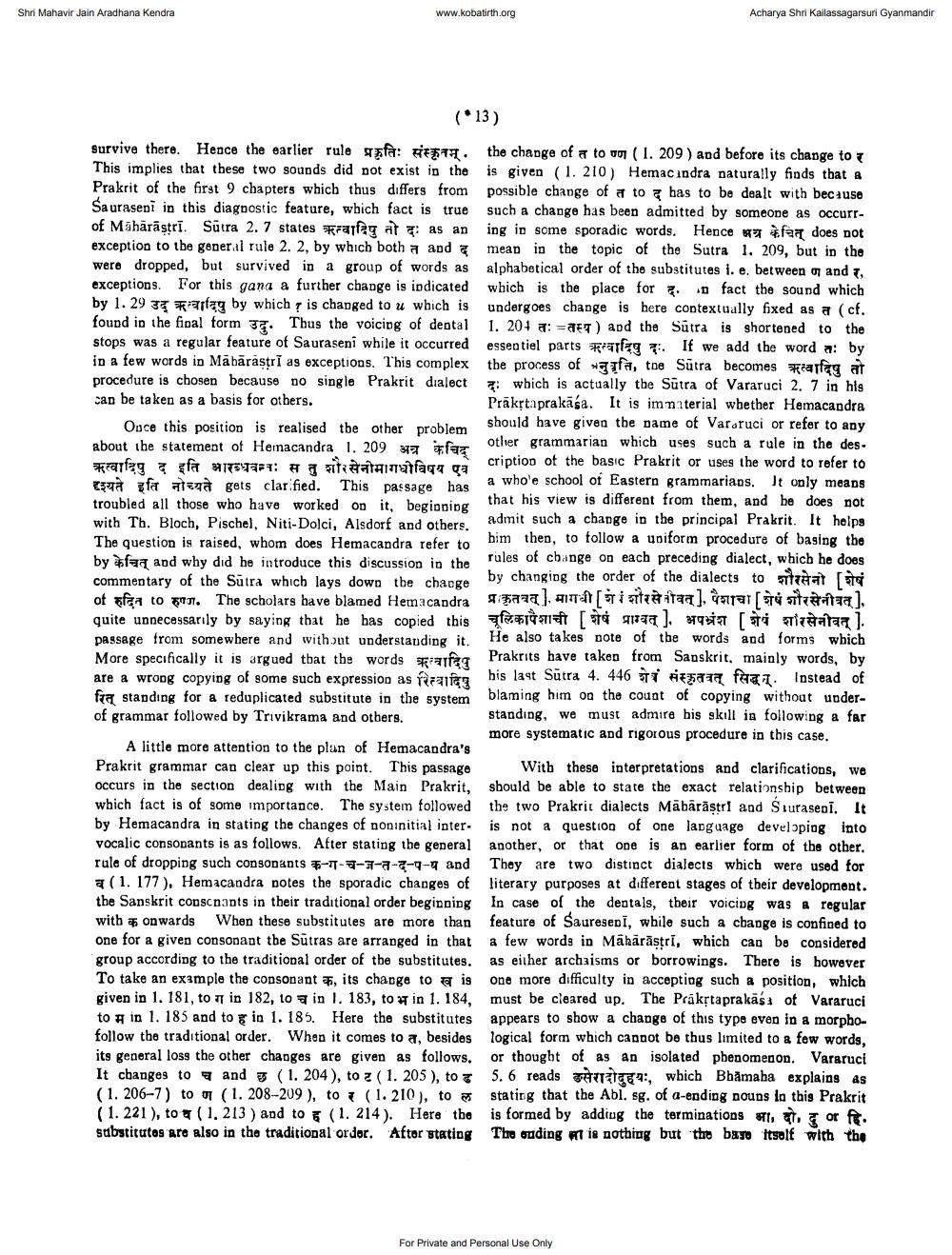________________
Shri Mahavir Jain Aradhana Kendra
www.kobatirth.org
Acharya Shri Kailassagarsuri Gyanmandir
(*13)
Survive there. Hence the earlier rule xfa: genta. the change of so to vot ( 1. 209 ) and before its change to y This implies that these two sounds did not exist in the is given (1. 210 ) Hemac indra naturally finds that a Prakrit of the first 9 chapters which thus differs from possible change of a to bas to be dealt with because Sauraseni in this diagnostic feature, which fact is true such a change has been admitted by someone as occurrof Māhārāstrī. Sutra 2. 7 states Frajfag ata as an ing in some sporadic words. Hence w raz does not exception to the general rule 2.2, by which both and mean in the topic of the Sutra 1, 209, but in the were dropped, but survived in a group of words as alphabetical order of the substitutes i. e. between a and 7, exceptions. For this gana a further change is indicated which is the place for en fact the sound which by 1. 29 7 *arlag by which ? is changed to u which is undergoes change is here contextually fixed as a (cf. found in the fipal form 3. Thus the voicing of dental 1. 204 a: = ET) apd the Sutra is shortened to the stops was a regular feature of Sauraseni while it occurred essentiel parts afg. If we add the word a: by in a few words in Mābārastrī as exceptions. This complex the process of fa, toe Sutra becomes #arfag at procedure is chosen because no single Prakrit dialect which is actually the Sūtra of Vararuci 2. 7 in his can be taken as a basis for others.
Prākta prakāśa. It is immaterial whether Hemacandra Once this position is realised the other problem
should have given the name of Vararucior refer to any about ibe statement of Hemacandra 1. 209 17 #faz
other grammarian which uses such a rule in the des
cription of the basic Prakrit or uses the word to refer to ऋत्वादिपु द इति आरब्धवानः स तु शोर सेनोमागधोविषय एवं a fa z a gets clar fied. This passage has
a whole school of Eastern grammarians. It only means troubled all those who have worked on it, begioning
that his view is different from them, and he does not with Th. Bloch, Pischel, Niti-Dolci, Alsdorf and others.
admit such a change in the principal Prakrit. It helps The question is raised, whom does Hemacandra refer to
bim then, to follow a uniform procedure of baging the by fun and why did be introduce this discussion in the
rules of change on each preceding dialect, which he does
teatras commentary of the Sutra which lays down the charge by changing the order of the dialects to of sfera to n. The scholars have blamed Hemacandra 1977). AT [T Te iraala s tertal. quite unnecessarily by saying that he has copied this feaseft naa). Tr i vaaraa l. passage from somewhere and without understanding it. He also takes note of the words and forms which More specifically it is argued that the words afat
Prakrits have taken from Sanskrit, mainly words, by are a wrong copying of some such expression as praias
his last Sutra 4. 446 Si s a faci instead of fra standing for a reduplicated substitute in the system
blaming him on the count of copying without underof grammar followed by Trivikrama and others.
standing, we must admire his skill is following a far
more systematic and rigorous procedure in this case. A little more attention to the plan of Hemacandra's Prakrit grammar can clear up this point. This passage With these interpretations and clarifications, we occurs in the section dealing with the Main Prakrit, should be able to state the exact relationship between which fact is of some importance. The systein followed the two Prakrit dialects Mābāråştri and Siuraseni. It by Hemacandra in stating the changes of noninitial inter is not a question of one language developing into vocalic consonants is as follows. After stating the general another, or that one is an earlier form of the other. rule of dropping such consonants 5--3-1-a-7-9-9 and They are two distinct dialects which were used for a (1. 177). Hemacandra notes the sporadic changes of literary purposes at different stages of their development. the Sanskrit conscnants in their traditional order beginning In case of the dentals, their voicing was a regular with onwards When these substitutes are more than feature of Saureseni, while such a change is confined to one for a given consonant the Sūtras are arranged in that a few words in Mahārāstri, which can be considered group according to the traditional order of the substitutes. as either archaisms or borrowings. There is however To take an example the consonant , its change to a is one more difficulty in accepting such a position, which given in 1. 181, to af in 182, 10 in 1. 183, to in 1.184, must be cleared up. The Prakstaprakāśa of Vararuci to in 1. 185 and to in 1. 185. Here the substitutes appears to show a change of this type even in a morphofollow the traditional order. When it comes to a, besides logical form which cannot be thus limited to a few words, its general loss the other changes are given as follows. or thought of as an isolated phenomenon. Vararuci It changes to and (1. 204), to z (1. 205 ), to 7 5.6 reads E, which Bhämaha explains as (1. 206-7) to op (1. 208-209). to (1.210), to stating that the Abl. sg. of a-ending nouns la thig Prakrit (1.221 ), to (1.213 ) and to (1.214). Here the is formed by adding the terminations
or ft. substitutos are also in the traditional order. After stating The Gading at is nothing but the bayo itself with the
For Private and Personal Use Only




